List of mammals of Yellowstone National Park
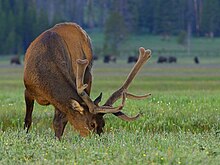

There are at least 67 species of mammals known to live within Yellowstone National Park, a 2,219,791 acres (898,318 ha)[1] protected area in the Rocky Mountains of Wyoming, Montana, and Idaho. Species are listed by common name, scientific name, typical habitat, and relative abundance.[2]
Canids
[edit]
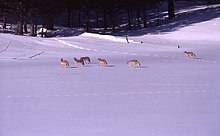
Order: Carnivora Family: Canidae
- Coyote (Canis latrans) valleys, grasslands, forests – common
- Northwestern wolf (Canis lupus occidentalis) valleys, grasslands, forests – common
- Wasatch mountain fox (Vulpes vulpes macroura) meadows, forests – common
Bears
[edit]
Order: Carnivora Family: Ursidae
- Grizzly bear (Ursus arctos horribilis) grasslands, forests, alpine tundra – common
- American black bear (Ursus americanus) forests – common
Raccoons
[edit]Order: Carnivora Family: Procyonidae
- Common raccoon (Procyon lotor) rivers, cottonwoods – rare
Felids
[edit]Order: Carnivora Family: Felidae
- Cougar (Puma concolor) forests, rock outcrops – uncommon
- Canada lynx (Lynx canadensis) coniferous forests – rare
- Bobcat (Lynx rufus) coniferous forests, rock outcroppings – common
Weasels
[edit]Order: Carnivora Family: Mustelidae
- Wolverine (Gulo gulo) alpine tundra, coniferous forests – rare
- North American river otter (Lontra canadensis) rivers – common
- Pacific marten (Martes caurina) coniferous forests – common
- American ermine or short-tailed weasel (Mustela richardsonii) willows, spruce forests – common
- Long-tailed weasel (Neogale frenata) forests, meadows, wetlands – common
- American mink (Neogale vison) streams, rivers – uncommon
- Fisher (Pekania pennanti) forests – rare
- American badger (Taxidea taxus) grasslands, sagebrush – common
Skunks
[edit]Order: Carnivora Family: Mephitidae
- Striped skunk (Mephitis mephitis) riparian forests – rare
Rabbits and hares
[edit]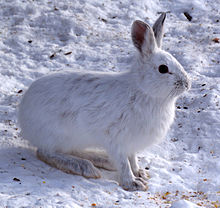
Order: Lagomorpha Family: Leporidae
- Mountain cottontail (Sylvilagus nuttallii) shrublands – common
- Desert cottontail (Sylvilagus audubonii) shrublands – common
- Snowshoe hare (Lepus americanus) coniferous forests, willows – common
- White-tailed jackrabbit (Lepus townsendii) sagebrush, grasslands – common
Pikas
[edit]Order: Lagomorpha Family: Ochotonidae
- American Pika (Ochotona princeps) alpine tundra, rocky areas – common
Bovids
[edit]
Order: Artiodactyla Family: Bovidae
- Plains bison (Bison bison bison) grasslands, sagebrush, shrubland – abundant
- Rocky Mountain bighorn sheep (Ovis canadensis canadensis) cliffs, rock outcroppings, alpine tundra – uncommon
- Mountain Goat (Oreamnos americanus) cliffs, rock outcroppings, alpine tundra – uncommon (non-native)
Pronghorn
[edit]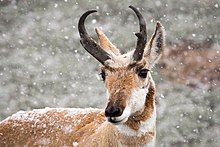
Order: Artiodactyla Family: Antilocapridae
- Pronghorn (Antilocapra americana) sagebrush, grassland – common
Elk, moose, and deer
[edit]
Order: Artiodactyla Family: Cervidae
- Northwestern white-tailed deer (Odocoileus virginianus ochrourus) grasslands, forests – uncommon
- Rocky Mountain mule deer (Odocoileus hemionus hemionus) grasslands, shrubland, forests – common
- Rocky Mountain elk (Cervus canadensis nelsoni) grasslands, shrubland, forest, alpine tundra – abundant
- Shiras moose (Alces alces shirasi) grasslands, forests, river, lakes – uncommon
Shrews
[edit]Order: Soricomorpha Family: Soricidae
- Dusky shrew (Sorex monticolus) meadows, forests – common
- Masked shrew (Sorex cinereous) meadows, forests – common
- American water shrew (Sorex palustris) meadows, riparian areas – common
- Preble's shrew (Sorex preblei) meadows, forests – rare, if present
- Dwarf shrew (Sorex nanus) meadows, forests – common.
Beavers
[edit]Order: Rodentia Family: Castoridae
- American beaver (Castor canadensis) riparian areas – fairly common, increasing
Squirrels
[edit]
Order: Rodentia Family: Sciuridae
- Least chipmunk (Neotamias minimus) meadows, forests – common
- Uinta chipmunk (Neotamias umbrinus) meadows, forests – common
- Yellow-pine chipmunk (Neotamias amoenus) meadows, forests – common
- American red squirrel (Tamiasciurus hudsonicus) coniferous forests – common
- Northern flying squirrel (Glaucomys sabrinus) forests – occasional
- Yellow-bellied marmot (Marmota flaventris) forests, meadows, rocky areas – common
- Uinta ground squirrel (Urocitellus armatus) meadows, sagebrush – common
- Golden-mantled ground squirrel (Callospermophilus lateralis) meadows, forests, rocky areas, alpine tundra – common
Voles and Woodrats
[edit]
Order: Rodentia Family: Cricetidae
- Common muskrat (Ondatra zibethicus) riparian – occasional
- Western heather vole (Phenacomys intermedius) sagebrush, grasslands, forest – occasional
- Water vole (Microtus richardsoni) riparian – occasional
- Long-tailed vole (Microtus longicaudus) meadows – common
- Southern red-backed vole (Myodes gapperi) coniferous forests – common
- Meadow vole (Microtus pennsylvanicus) meadows – common
- Montane vole (Microtus montanus) meadows, sagebrush, riparian – common
- Bushy-tailed woodrat (Neotoma cinerea) rocky areas – common
Mice
[edit]
Order: Rodentia Family: Cricetidae
- Deer mouse (Peromyscus maniculatus) grasslands – common
Jumping mice
[edit]Order: Rodentia Family: Dipodidae
- Western jumping mouse (Zapus princeps) riparian – occasional
Porcupines
[edit]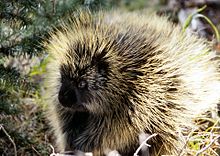
Order: Rodentia Family: Erethizontidae
- North American porcupine (Erethizon dorsatum) forests, sagebrush, riparian – common
Bats
[edit]
Order: Chiroptera Family: Vespertilionidae
- Little brown bat (Myotis lucifugus) roosts in caves, trees, buildings – common
- Big brown bat (Eptesicus fuscus) roosts in sheltered areas – common
- Long-eared myotis (Myotis evotis) roosts on cliffs, buildings – uncommon
- Long-legged myotis (Myotis volans) roosts in cliffs, tree cavities, buildings – common
- Townsend's big-eared bat (Coryhinus townsendii) roosts in caves – uncommon
- Fringe-tailed bat (Myotis thysanodes) roosts in cliffs, snags – uncommon
- Hoary bat (Lasiurus cinereus) roosts in trees – uncommon
- Silver-haired bat (Lasionycteris noctivagans) roosts in trees, snags – common
- Spotted bat (Euderma maculatum) roosts on cliffs, trees – uncommon
- Pallid bat (Antrozous pallidus) roosts on cliffs, caves, buildings – uncommon
- California myotis (Myotis californicus) roosts in trees, rock crevices, and buildings
- Western small-footed myotis (Myotis ciliolabrum) roosts in caves, rocky areas – rare
- Yuma myotis (Myotis yumanensis) roosts in caves, buildings, trees – rare
See also
[edit]Further reading
[edit]- Streubel, Donald P. (1995). Small Mammals of the Yellowstone Ecosystem. Boulder, CO: Robert Rineharts. ISBN 0-911797-59-9.
- Broderick, Harold J. (1954). Wild Animals of Yellowstone National Park. Yellowstone Library and Museum Association, Yellowstone National Park, National Park Service.
References
[edit]- ^ "Listing of acreage – December 31, 2011" (XLSX). Land Resource Division, National Park Service. Retrieved March 8, 2012. (National Park Service Acreage Reports)
- ^ "Mammals". Yellowstone National Park. National Park Service.
